Abstract
In 22 families with the "pure" form of hereditary spastic paraplegia inheritance was autosomal dominant in 19 and autosomal recessive in three. Examination of intrafamilial correlation of age of onset in the dominant cases suggested that the disorder is genetically heterogeneous. Two forms of dominant hereditary spastic paraplegia were identified: one with an age of onset mostly below 35 years (type I), and the other onset usually over 35 years (type II). In the type I cases, delay in walking was not infrequent and spasticity of the lower limbs was more marked than weakness. The disorder was very slowly progressive and was extremely variable in terms of severity. Sixteen per cent of the patients aged over 20 years were asymptomatic but clinically affected. In the type II group muscle weakness, urinary symptoms and sensory loss were more marked. This form of the disease evolved more rapidly. In the three families demonstrating autosomal recessive inheritance the clinical features were very similar to those of the dominant cases. Biological fitness of patients from both the dominant groups was not impaired and no definite evidence of new mutation was observed. A cumulative frequency curve of age of onset in the type I group was constructed with suggested that an asymptomatic child of an affected parent has a 20% chance of developing the disease at the age of 25 years; the risk is probably even less if the child is clinically normal.
Full text
PDF

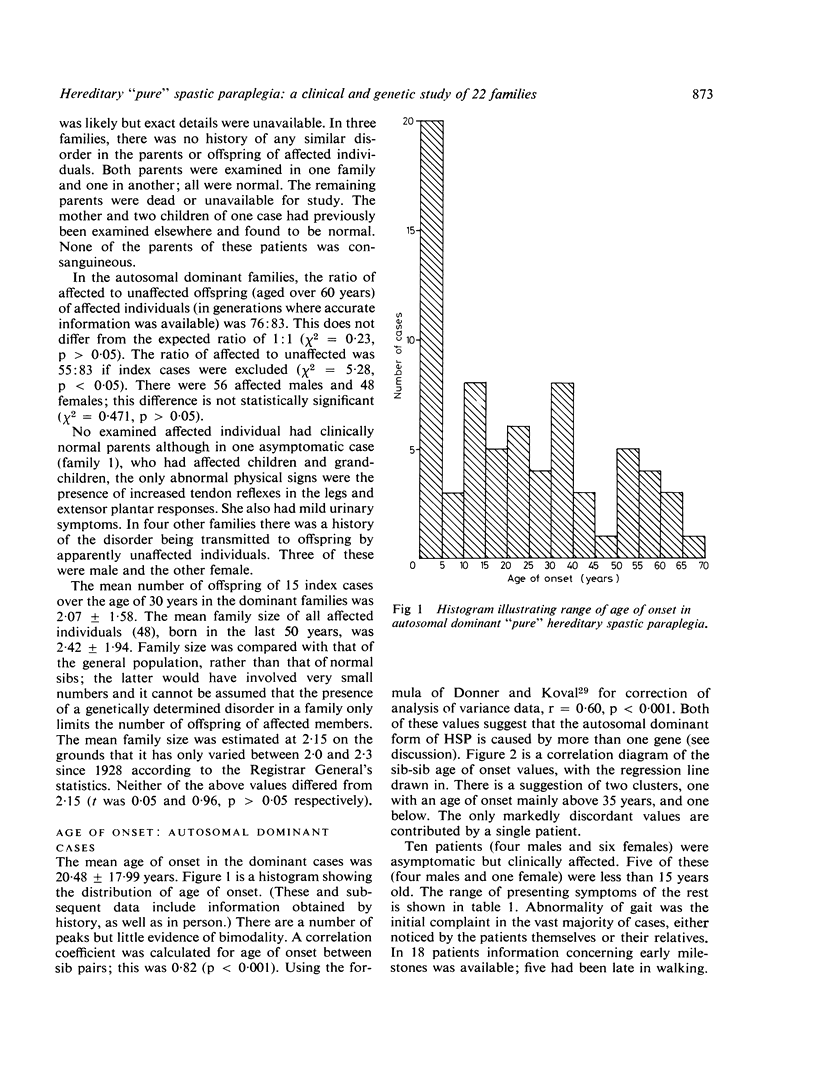
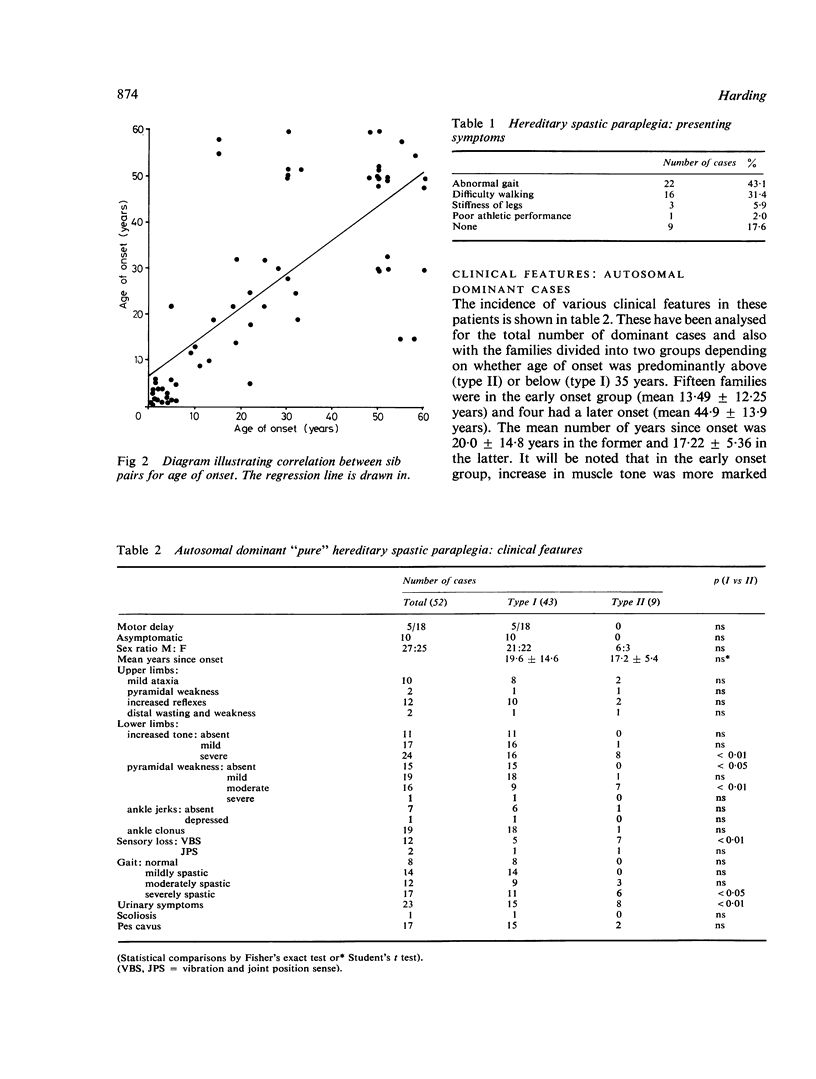


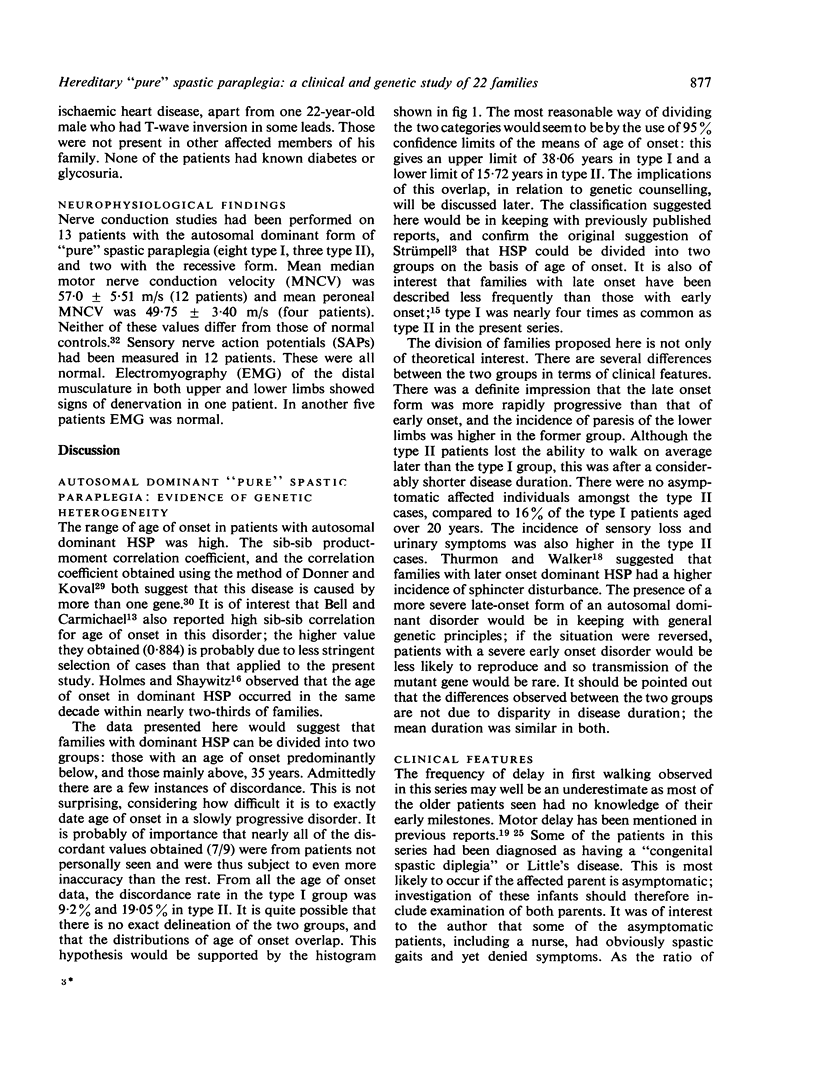
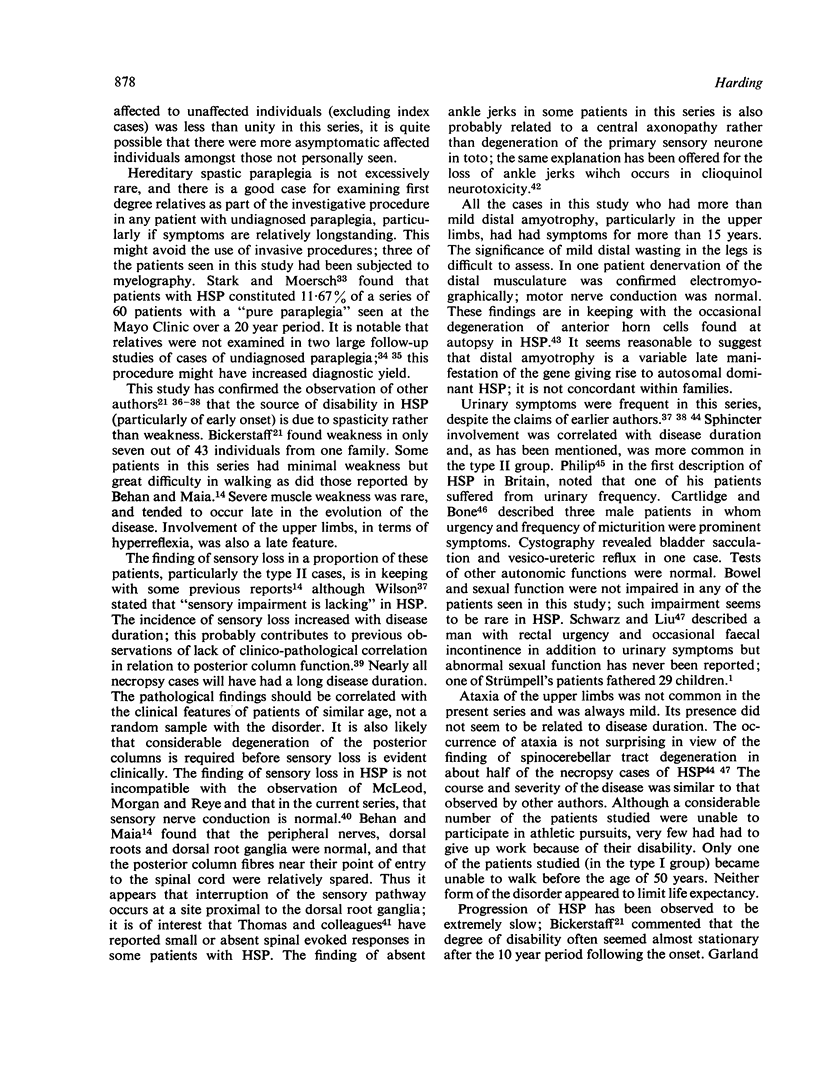
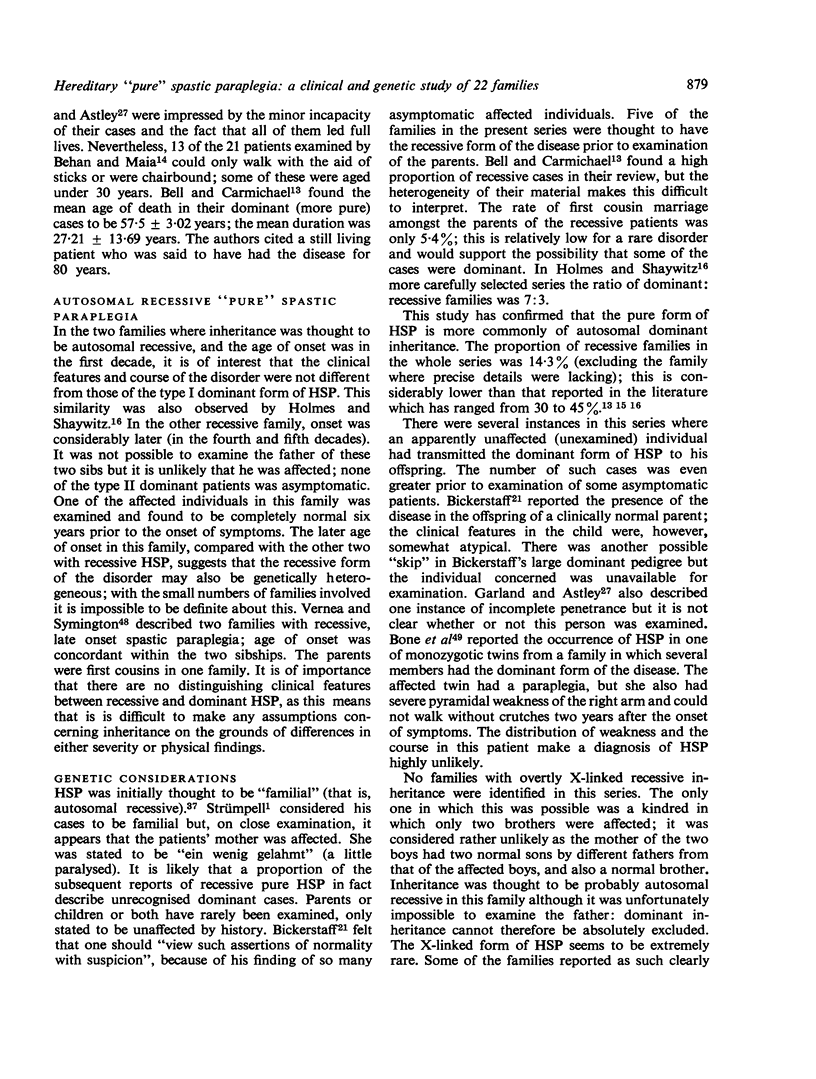
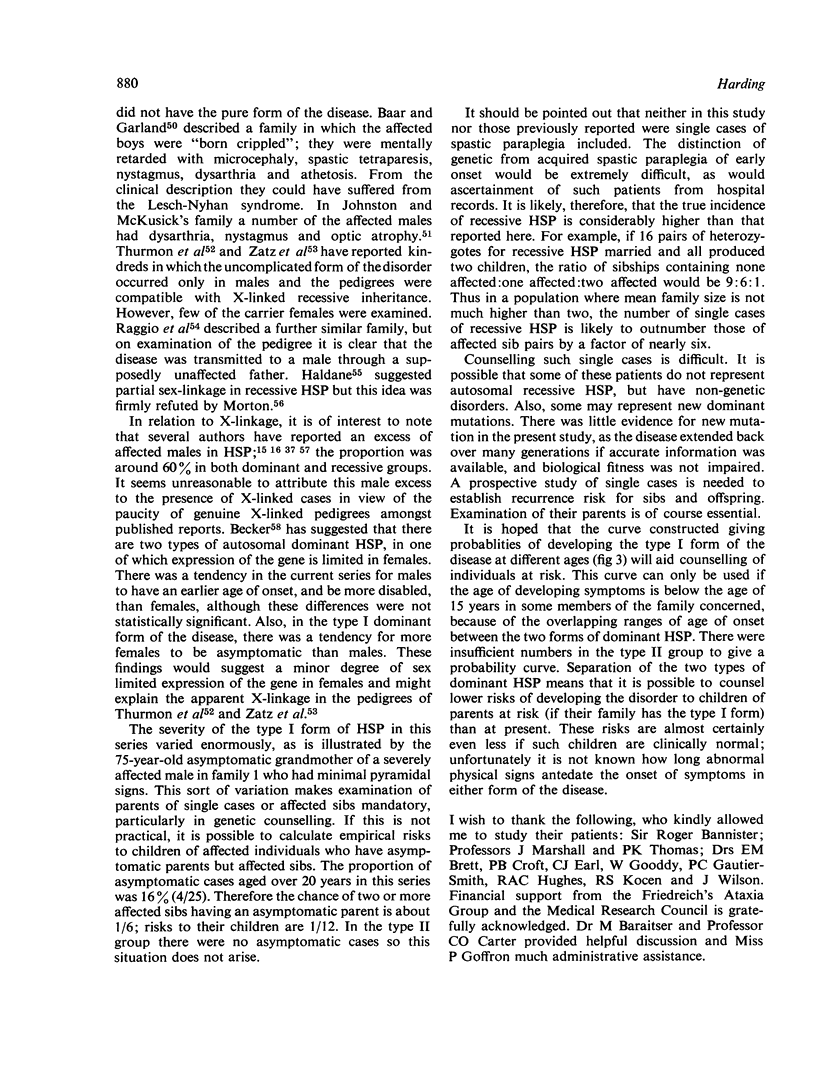
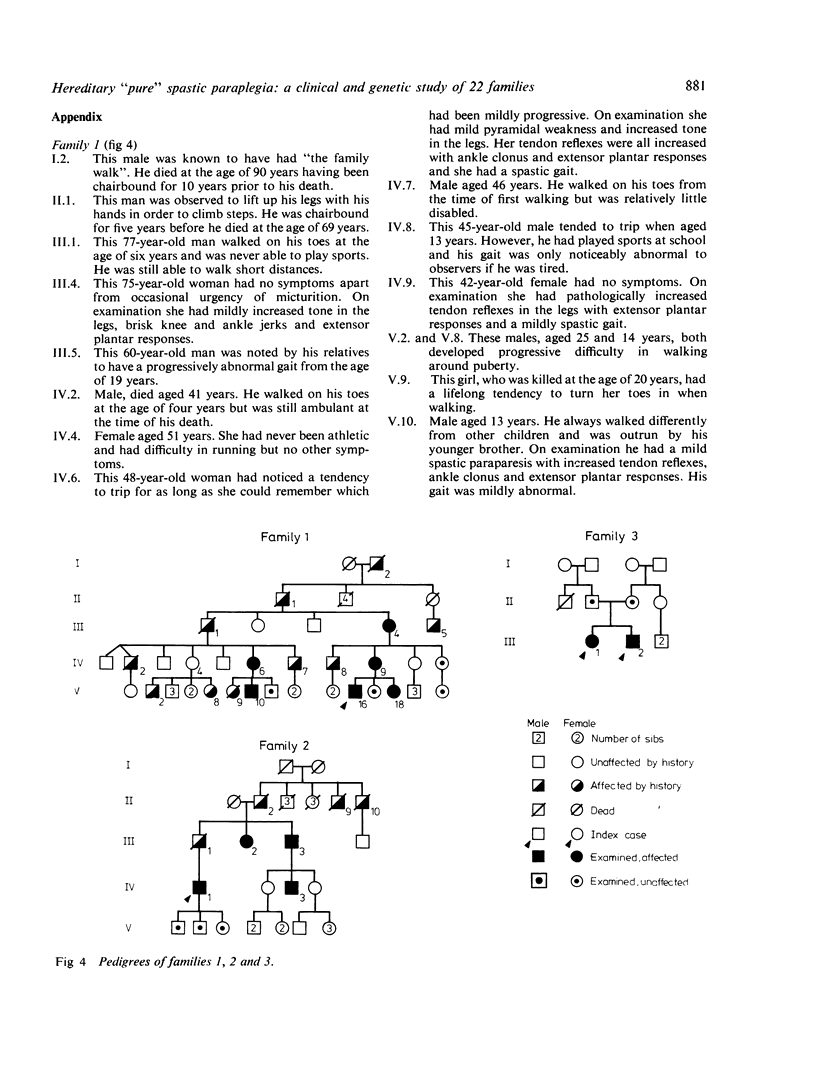
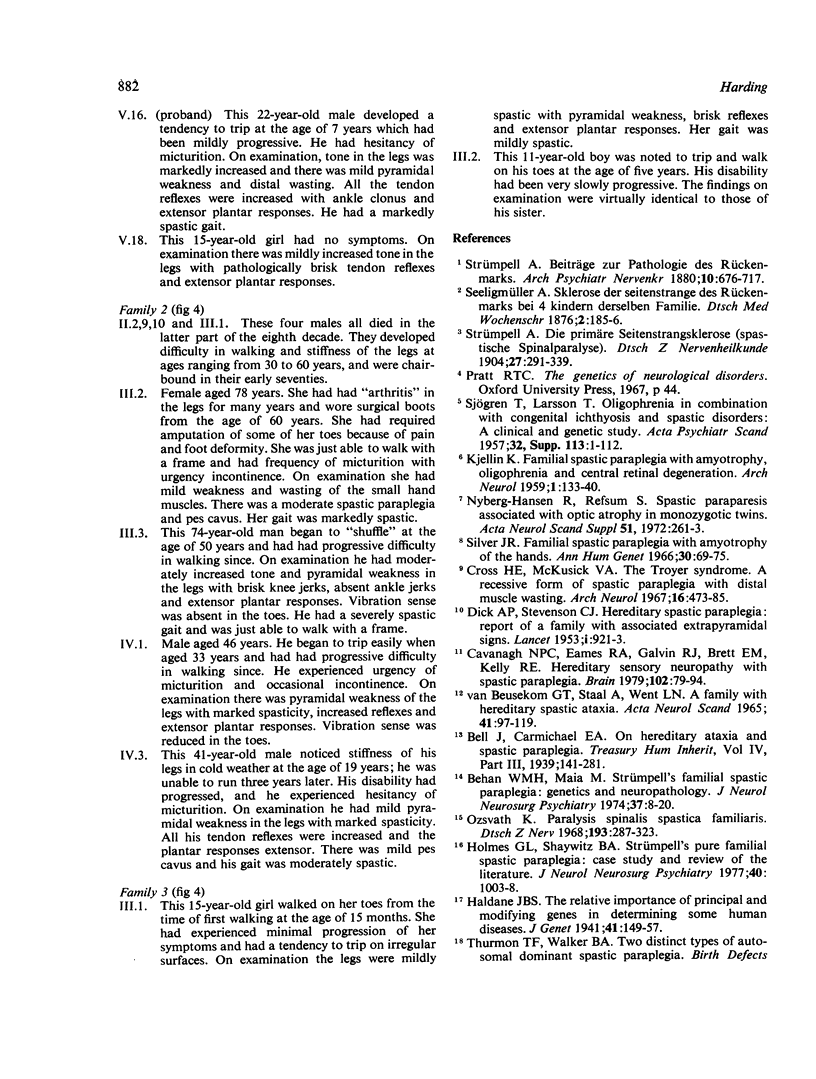
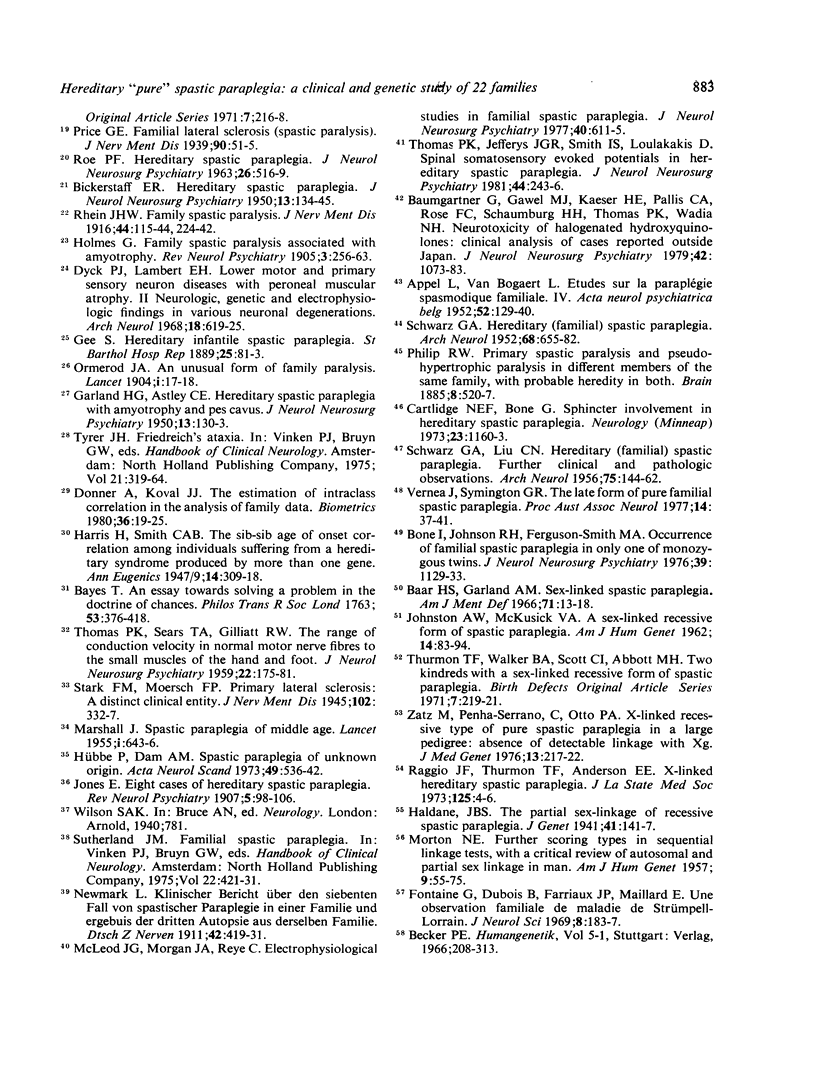
Selected References
These references are in PubMed. This may not be the complete list of references from this article.
- APPEL L., VAN BOGAERT L. Etudes sur la paraplégie spasmodique familiale. IV. La famille Fev...: forme très tardive; contribution histopathologique. Acta Neurol Psychiatr Belg. 1952 Mar;52(3):129–140. [PubMed] [Google Scholar]
- BICKERSTAFF E. R. Hereditary spastic paraplegia. J Neurol Neurosurg Psychiatry. 1950 May;13(2):134–145. doi: 10.1136/jnnp.13.2.134. [DOI] [PMC free article] [PubMed] [Google Scholar]
- Baar H. S., Gabriel A. M. Sex-linked spastic paraplegia. Am J Ment Defic. 1966 Jul;71(1):13–18. [PubMed] [Google Scholar]
- Baumgartner G., Gawel M. J., Kaeser H. E., Pallis C. A., Rose F. C., Schaumburg H. H., Thomas P. K., Wadia N. H. Neurotoxicity of halogenated hydroxyquinolines: clinical analysis of cases reported outside Japan. J Neurol Neurosurg Psychiatry. 1979 Dec;42(12):1073–1083. doi: 10.1136/jnnp.42.12.1073. [DOI] [PMC free article] [PubMed] [Google Scholar]
- Behan W. M., Maia M. Strümpell's familial spastic paraplegia: genetics and neuropathology. J Neurol Neurosurg Psychiatry. 1974 Jan;37(1):8–20. doi: 10.1136/jnnp.37.1.8. [DOI] [PMC free article] [PubMed] [Google Scholar]
- Bone I., Johnson R. H., Ferguson-Smith M. A. Occurrence of familial spastic paraplegia in only one of monozygous twins. J Neurol Neurosurg Psychiatry. 1976 Nov;39(11):1129–1133. doi: 10.1136/jnnp.39.11.1129. [DOI] [PMC free article] [PubMed] [Google Scholar]
- Cartlidge N. E., Bone G. Sphincter involvement in hereditary spastic paraplegia. Neurology. 1973 Nov;23(11):1160–1163. doi: 10.1212/wnl.23.11.1160. [DOI] [PubMed] [Google Scholar]
- Cavanagh N. P., Eames R. A., Galvin R. J., Brett E. M., Kelly R. E. Hereditary sensory neuropathy with spastic paraplegia. Brain. 1979 Mar;102(1):79–94. doi: 10.1093/brain/102.1.79. [DOI] [PubMed] [Google Scholar]
- Cross H. E., McKusick V. A. The Troyer syndrome. A recessive form of spastic paraplegia with distal muscle wasting. Arch Neurol. 1967 May;16(5):473–485. doi: 10.1001/archneur.1967.00470230025003. [DOI] [PubMed] [Google Scholar]
- DICK A. P., STEVENSON C. J. Hereditary spastic paraplegia; report of a family with associated extrapyramidal signs. Lancet. 1953 May 9;1(6767):921–923. doi: 10.1016/s0140-6736(53)92061-3. [DOI] [PubMed] [Google Scholar]
- Donner A., Koval J. J. The estimation of intraclass correlation in the analysis of family data. Biometrics. 1980 Mar;36(1):19–25. [PubMed] [Google Scholar]
- Dyck P. J., Lambert E. H. Lower motor and primary sensory neuron diseases with peroneal muscular atrophy. II. Neurologic, genetic, and electrophysiologic findings in various neuronal degenerations. Arch Neurol. 1968 Jun;18(6):619–625. doi: 10.1001/archneur.1968.00470360041003. [DOI] [PubMed] [Google Scholar]
- Fontaine G., Dubois B., Farriaux J. P., Maillard E. Une observation familiale de maladie de Strümpell-Lorrain. J Neurol Sci. 1969 Jan-Feb;8(1):183–187. doi: 10.1016/0022-510x(69)90049-5. [DOI] [PubMed] [Google Scholar]
- GARLAND H. G., ASTLEY C. E. Hereditary spastic paraplegia with amyotrophy and pes cavus. J Neurol Neurosurg Psychiatry. 1950 May;13(2):130–133. doi: 10.1136/jnnp.13.2.130. [DOI] [PMC free article] [PubMed] [Google Scholar]
- Holmes G. L., Shaywitz B. A. Strumpell's pure familial spastic paraplegia: case study and review of the literature. J Neurol Neurosurg Psychiatry. 1977 Oct;40(10):1003–1008. doi: 10.1136/jnnp.40.10.1003. [DOI] [PMC free article] [PubMed] [Google Scholar]
- Hübbe P., Mouritzen Dam A. Spastic paraplegia of unknown origin. A follow-up of 32 patients. Acta Neurol Scand. 1973;49(4):536–542. doi: 10.1111/j.1600-0404.1973.tb01326.x. [DOI] [PubMed] [Google Scholar]
- JOHNSTON A. W., McKUSICK V. A. A sex-linked recessive form of spastic paraplegia. Am J Hum Genet. 1962 Mar;14:83–94. [PMC free article] [PubMed] [Google Scholar]
- KJELLIN K. Familial spastic paraplegia with amyotrophy, oligophrenia, and central retinal degeneration. Arch Neurol. 1959 Aug;1:133–140. doi: 10.1001/archneur.1959.03840020007002. [DOI] [PubMed] [Google Scholar]
- LANCE J. W. Sporadic and familial varieties of tonic seizures. J Neurol Neurosurg Psychiatry. 1963 Feb;26:51–59. doi: 10.1136/jnnp.26.1.51. [DOI] [PMC free article] [PubMed] [Google Scholar]
- MARSHALL J. Spastic paraplegia of middle age; a clinicopathological study. Lancet. 1955 Mar 26;268(6865):643–646. doi: 10.1016/s0140-6736(55)90317-2. [DOI] [PubMed] [Google Scholar]
- MORTON N. E. Further scoring types in sequential linkage tests, with a critical review of autosomal and partial sex linkage in man. Am J Hum Genet. 1957 Mar;9(1):55–75. [PMC free article] [PubMed] [Google Scholar]
- McLeod J. G., Morgan J. A., Reye C. Electrophysiological studies in familial spastic paraplegia. J Neurol Neurosurg Psychiatry. 1977 Jun;40(6):611–615. doi: 10.1136/jnnp.40.6.611. [DOI] [PMC free article] [PubMed] [Google Scholar]
- Nyberg-Hansen R., Refsum S. Spastic paraparesis associated with optic atrophy in monozygotic twins. Acta Neurol Scand Suppl. 1972;51:261–263. [PubMed] [Google Scholar]
- Ozsváth K. Paralysis spinalis spastica familiaris. Dtsch Z Nervenheilkd. 1968 Jun 5;193(4):287–323. [PubMed] [Google Scholar]
- Raggio J. F., Thurmon T. F., Anderson E. E. X-linked hereditary spastic paraplegia. J La State Med Soc. 1973 Jan;125(1):4–5. [PubMed] [Google Scholar]
- SCHWARZ G. A. Hereditary (familial) spastic paraplegia. AMA Arch Neurol Psychiatry. 1952 Nov;68(5):655–662. doi: 10.1001/archneurpsyc.1952.02320230081010. [DOI] [PubMed] [Google Scholar]
- SCHWARZ G. A., LIU C. N. Hereditary (familial) spastic paraplegia; further clinical and pathologic observations. AMA Arch Neurol Psychiatry. 1956 Feb;75(2):144–162. doi: 10.1001/archneurpsyc.1956.02330200038005. [DOI] [PubMed] [Google Scholar]
- SJOGREN T., LARSSON T. Oligophrenia in combination with congenital ichthyosis and spastic disorders; a clinical and genetic study. Acta Psychiatr Neurol Scand Suppl. 1957;113:1–112. [PubMed] [Google Scholar]
- Silver J. R. Familial spastic paraplegia with amyotrophy of the hands. Ann Hum Genet. 1966 Jul;30(1):69–75. doi: 10.1111/j.1469-1809.1966.tb00007.x. [DOI] [PubMed] [Google Scholar]
- THOMAS P. K., SEARS T. A., GILLIATT R. W. The range of conduction velocity in normal motor nerve fibers to the small muscles of the hand and foot. J Neurol Neurosurg Psychiatry. 1959 Aug;22:175–181. doi: 10.1136/jnnp.22.3.175. [DOI] [PMC free article] [PubMed] [Google Scholar]
- Thomas P. K., Jefferys J. G., Smith I. S., Loulakakis D. Spinal somatosensory evoked potentials in hereditary spastic paraplegia. J Neurol Neurosurg Psychiatry. 1981 Mar;44(3):243–246. doi: 10.1136/jnnp.44.3.243. [DOI] [PMC free article] [PubMed] [Google Scholar]
- Thurmon T. F., Walker B. A., Scott C. I., Abbott M. H. Two kindreds with a sex-linked recessive form of spastic paraplegia. Birth Defects Orig Artic Ser. 1971 Feb;7(1):219–221. [PubMed] [Google Scholar]
- VAN BEUSEKOMG, STAAL A., WENT L. N. A FAMILY WITH HEREDITARY SPASTIC ATAXIA: AN INVESTIGATION INTO THE EXISTENCE OF THE SO CALLED "FORMES FRUSTES". Acta Neurol Scand. 1965;41:97–119. doi: 10.1111/j.1600-0404.1965.tb04284.x. [DOI] [PubMed] [Google Scholar]
- Vernea J., Symington G. R. The late form of pure familial spastic paraplegia. Clin Exp Neurol. 1977;14:37–41. [PubMed] [Google Scholar]
- Zatz M., Penha-Serrano C., Otto P. A. X-linked recessive type of pure spastic paraplegia in a large pedigree: absence of detectable linkage with Xg. J Med Genet. 1976 Jun;13(3):217–222. doi: 10.1136/jmg.13.3.217. [DOI] [PMC free article] [PubMed] [Google Scholar]


